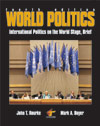 |  World Politics: International Politics on the World Stage, Brief, 4/e John T. Rourke,
University of Connecticut - Storrs
Mark A. Boyer,
University of Connecticut - Storrs
The Evolution of World Politics
An Age of Bipolarity- The Cold War ca. 1970 An Age of Bipolarity- The Cold War ca. 1970 (75.0K) An Age of Bipolarity- The Cold War ca. 1970 (75.0K)Following the Second World War, the world was divided
into two armed camps led by the United States and the Soviet Union.
The Soviet Union and its allies, the Warsaw Pact countries, feared
a U.S.-led takeover of the eastern European countries that became
Soviet satellites after the war and the replacing of a socialist political
and economic system with a liberal one. The United States and its
allies, the NATO (North Atlantic Treaty Organization) countries, equally
feared that the USSR would overrun western Europe. Both sides sought
to defend themselves by building up massive military arsenals. The
United States, adopting an international geopolitical strategy of
"containment," sought to ring the Soviet Union with a string
of allied countries and military bases that would prevent Soviet expansion
in any direction. The levels of spending on military hardware contributed
to the devolution of the Soviet Union and the obsolescence of alliances
and military bases in an age of advanced guidance and delivery systems
made the U.S. military containment less necessary. Following a peak
in the early 1960s, the cold war gradually became less significant
and the age of bipolar international power essentially ended with
the dissolution of the USSR. |
|



 2002 McGraw-Hill Higher Education
2002 McGraw-Hill Higher Education